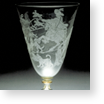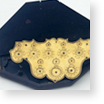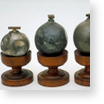This room contains many instruments utilized in research conducted by the members of the Accademia del Cimento. Founded in 1657 by Grand Duke Ferdinando II and Prince Leopoldo de' Medici, it was the first European society exclusively devoted to science, preceding the foundation of the Royal Society in London (1660) and the Académie Royale des Sciences in Paris (1666). Following in the footsteps of Galileo, the Cimento conducted experiments to verify some principles of natural philosophy hitherto universally accepted on the basis of Aristotle's authority. The Academy concluded its work in 1667 by publishing the Essays on natural experiments, summarizing its activity. Significant results were attained in observations of Saturn, and above all in the fields of barometry and thermometry (here we see the superb thermometers and glass instruments used by the Academy). Numerous experiments were designed to verify the possibility of creating a vacuum in nature, and observing its effects on animals and objects.
The Thermometers of the Accademia: Art and Science in Glassware
By demonstrating that the height of a column of mercury in a barometer tube rises or falls with changing temperatures, Torricelli's experiment (Spring ...
(87 objects)
Superb Instruments and Calculating Devices
Outstanding among the activities of the Accademia del Cimento were the experiments designed to determine the speed of sound, utilizing an odometer with ...
(5 objects)
The Vacuum and the Physics of Fluids
The Florentine Accademia conducted intense experimentation on the physics of air, conceiving and building the earliest models of the barometer and hygrometer. ...












